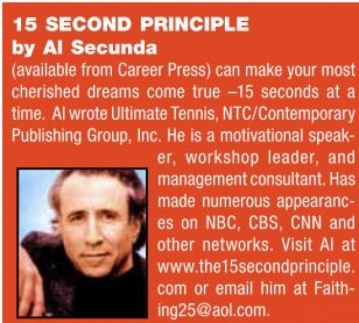
Nature can provide us with a wonderful in sight in to the growing and learning process. There is a fascinating species of bamboo called the Dendrocalamus gigantius. After being planted, it does not show any apparent signs of growth for several years. From an underground perspective, however, an enormous amount of activity continually occurs. Before ever beginning its upward ascent, the plant builds a huge network of roots that spreads deep and wide. The anchoring process can take years to weave.
Once the subterranean support system is in place, the Dendrocalamus gigantius begins its upward journey. During this phase, the plant will grow at an astounding rate of 2 to 3 feet a day. Scientists report that by sitting very still, you can almost see the shoots grow. Within several weeks the plant will reach a height of approximately l20 feet.
The question can be asked, how long did it take for this plant to reach l20 feet? Is the answer four weeks or four years? I believe we must include the total gestation period along with the vertical sprinting period. Just because we can’t see results and physically measure them doesn’t mean that growth and progress aren’t happening.
As creators, we also need to spend more time developing our own subterranean support system. Before manifesting our dreams, we need to create a deep and wide web of training, planning, and experiencing. It’s important to realize that materializing our creation is the last in a series of important growth steps. Skyscraper contractors take years drawing up blueprints and digging way down into the earth before ever building skyward.
In a culture desiring instant results and immediate satisfaction, perhaps we are building up before digging down.
- How many small businesses fail because people neglected to raise sufficient capital, do enough research, and get adequate training?
- How many books aren’t sold because writers rush the creative process? Submitting a book or proposal before it has been wellthought-out, polished, and “empassioned,” is a sure way to rejection.
- How many actors fail because their motivation for fame is greater than their motivation for building a solid acting technique and developing strong business skills?
As dedicated seekers, we need patience and trust during our own personal gestation periods. Lowell Ganz, screenwriter of such classic blockbusters as City Slickers, Splash, and Parenthood, told me that it takes him and his partner, Babaloo Mandel, more time working out the characters, scenes, and plot than it does to create the l20 pages of actual dialogue.
Tim Gallwey, creator of the bestseller, Inner Tennis, wrote the book in a very short period of time. What’s not mentioned is that he studied Eastern thought and meditation for many years before ever writing the book.
It is said that King David’s Temple in Jerusalem took ten years to build. The first eight years were spent on drawing the plans and cutting the individual huge stones.
Likewise, another species of bamboo called the Fargesia Dracocephala will flower between 40 and 60 years after it is planted. It is also interesting to note that The Grateful Dead were on the music scene for 2l years before they had a hit single with “Touch of Grey.” It took Bonnie Raitt l8 years and 10 albums before she had a hit with “Something to Talk About.” And Michael Jordan, perhaps the greatest basketball player ever to play the game, failed to make his high school varsity team in his sophomore year.
Each person, like each species, is unique unto itself. We each have our own maturation timetable which should be honored. We must give ourselves (and our children) permission to grow and unfold at our own pace. There are five pitfalls to performing excellence that will prevent this from happening: 1) Comparing our progress with that of our contemporaries, 2) not believing in ourselves enough, 3) feeling it’s too late to begin, 4) looking for constant approval, and 5) wanting to control the precise outcome of every endeavor. We should maintain a constant vigilance and not allow these pitfalls to prevent us from following our hearts and staying committed to our mission.
Why should we be in such a desperate haste to succeed and in such desperate enterprises?
If man does not keep pace with his companions, perhaps it is because he hears a different drummer.
Let him step to the music which he hears, however measured or far away. Henry David Thoreau
By nipping these limiting habits in the bud, you will be less likely to demand visible results every minute of every day. Being relentlessly consumed with measurable progress is not the most masterful way to approach your dreams or life. Instead, what is most important is to keep showing up with passion, patience, planning, and practice.
A gentle yet cautionary word is also needed here. Make sure that your “rooting process” also contains integrity. There is a time for contemplation and a time for manifestation. You want to have respect for your own maturation process, but be sure not to let fear, distractions, and laziness masquerade as preparation, rejuvenation, and meditation. As Will Rogers advised us, “Even if you’re on the right track, you’ll get run over if you just sit there.”
Eventually, tangible mini-actions must also be taken. Although the tortoise did beat the hare, he won by getting out on the road and walking at his own pace toward his goal. He didn’t win by sitting under a tree and sulking about his difficult lot in life - short legs, a thick neck, and a heavy load. At some point, if your phobias, misgivings, and shortcomings refuse to go away, you will have to pick them up, embrace them, and carry them across that imaginary primal threshold that separates rumination from creation. When you do, miraculous things will happen.
